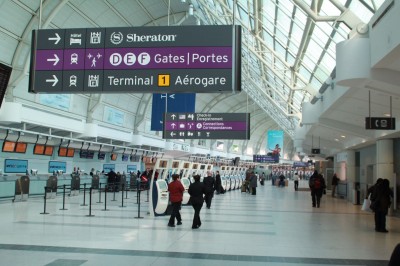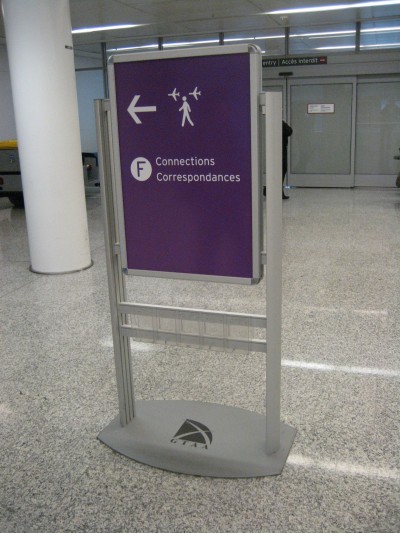The alphabetic zones mean some signs could be simplified. A sign face that previously read ‘Gates 101 to 157,’ for example, could now instead read, ‘D Gates.’ With the extra layer of wayfinding information, a passenger is directed to his/her zone first, then to his/her specific gate. There is also less need to use three pictograms to indicate the three types of flights, which can be confusing to passengers from other countries who are used to only seeing two (i.e. domestic and international).
From concept to reality
To design the new signs and retrofits, GTAA consulted with Entro, a Toronto-based environmental graphic design (EGD) firm—now Entro G+A—that had worked on earlier signs for the airport. Its T1 signs could be updated by changing out the ‘blades,’ whereas T3 needed full sign face replacements.
Entro began studying the rezoning concepts in November 2010 and developed a strategic plan and new sign designs, which were finalized by April 2011. One of the most fundamental changes was choosing a pictogram for the purple connections signs.
“We worked with GTAA to adapt an image from those that would appear too small on the overhead blades,” says Vincent Matthieu Gratton, associate at Entro. “The resulting pictogram features a person walking between two planes. Its orientation can be flipped whenever helpful in terms of indicating direction.”
Production of the new signs began in September 2011. Zip Signs in Burlington, Ont., handled all of the fabrication and installation. This meant measuring and dry-fitting every sign to ensure the newly manufactured blades would fit correctly.
WSI Sign Systems in Bolton, Ont., which had worked on earlier Entro-designed components, produced all of the signs for the new connection centres.
In the meantime, GTAA raised awareness of the impending changes by distributing printed posters and training DVDs for its own staff, the airline carriers, the fire department, Pearson’s communications centre and all other tenants of the airport.
The big night
Perhaps the most daunting part of the project was the January 30 overnight installation that marked the changeover from the old system to the new zones. In addition to Zip Signs working in T1, Toronto-based Sign Fix handled installations in T3. In some cases, temporary vinyl sign faces had already been applied over new zonal signs in T3, so these could simply be removed at the last minute.
“Between the two terminals, there were 50 people in four crews changing about 800 signs in one night,” Wiszniewski says. “To facilitate everything, some of us lived here from Sunday, January 29 to Tuesday, January 31. We set up a command centre to help everyone whose work in the airport would be affected by the change. So much infrastructure is dependent on the gate numbers, from the public address (PA) system to the electronic flight and baggage displays to the airport’s website. Our information technology (IT) department had to start its changeover three hours in advance that night.”
Ensuring smooth operations was especially important on the night of the season’s first significant snowstorm, when 50 mm (2 in.) of snow fell within three hours.
“We missed three critical signs out of the 800, which caused some confusion for the first hour in the morning, from 5 a.m. to 6 a.m. on January 31,” says Wiszniewski. “We had to scramble to get those replaced, but we also had extra staff on hand to help passengers find their gates. On that first day of the new system, we had 70,000 people come through the airport and there were no complaints.”







